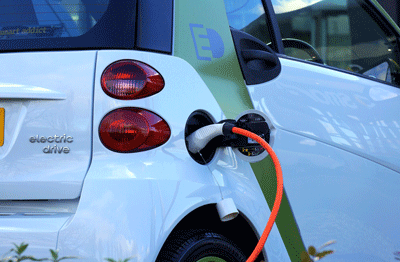Despite an entire 2006 documentary about its death, the electric car is back and is transforming transportation. Center director Jeffrey Cole has the story.
______________________________
By Jeffrey Cole
Sometimes it is astonishing how quickly a new technology can morph from a novelty — or even a joke — into a new way of doing things that will forever change the world. Few technologies have gone through this cycle faster than electric cars.
 When I was a kid, there were conspiracy theories claiming secret inventions that could produce vast amounts of inexhaustible energy at ridiculously low prices. The problem was oil and automobile companies buying off inventors and forever suppressing the new technologies that could profoundly impact their business. Some of these theories reached fever pitch during the fuel crises of 1973 and 1979, when the nation desperately looked for alternatives to seeking oil from OPEC.
When I was a kid, there were conspiracy theories claiming secret inventions that could produce vast amounts of inexhaustible energy at ridiculously low prices. The problem was oil and automobile companies buying off inventors and forever suppressing the new technologies that could profoundly impact their business. Some of these theories reached fever pitch during the fuel crises of 1973 and 1979, when the nation desperately looked for alternatives to seeking oil from OPEC.
Nothing ever became of the theories, but they received some strong support in 2006 when Chris Paine released his award-winning documentary, Who Killed the Electric Car? The film showed that the electric car, powered by a genuine alternative to fossil fuels, was on its way to deployment in America when suddenly the existing models were recalled and then unable to be purchased or leased– no matter the demand. Then they disappeared completely. The culprits were the old targets of the conspiracy theories: oil companies, automobile companies, the government, and the California Air Resources Board.
Whether a conspiracy theory or not, the promising introduction of electric cars in the 1990s was quickly snuffed out. Oil companies were protected from a serious threat, and automobile companies were saved from massive development and marketing costs for a new type of vehicle.
The system worked for everyone except the consumer.
What is compelling is that within two years of a film proclaiming the death of electric cars, Tesla released its first fully electric car, the Roadster. It was a remarkable feat of engineering, but it was really a prototype of what was to come. Tesla only sold 2,400 Roadsters, mostly outside the United States. But the Roadster gave Tesla confidence in electricity as a real alternative form of power.
Six years after Who Killed the Electric Car?, Tesla released a completely revolutionary car, the Model S. Today, six years later, the S still dazzles people with its technology and styling. It sets the standard for both electric cars and luxury cars.
Although there have been some minor styling top-offs and added features, the Model S is essentially the same car that Tesla released in 2012. In six years, no other automobile company has come close to matching Tesla. In 2019 — it took them 7 years! — Porsche, Jaguar, Audi and others will try.
Fighting oil companies, automobile companies, government bureaucracy, and lobbyists — as well as reluctant consumers — Tesla has helped to establish electric-powered cars as the wave of the future.
The tipping point towards electric cars was reached in 2017, and now the full movement of the industry is toward electricity. It is easy to see that the Internal Combustion Engine is headed to the scrap heap of history along with the horse and buggy, Blockbuster Video stores, phone booths, and One-Hour Fotomats.
Here is the evidence:
1.The Internal Combustion Engine is beginning to disappear. Next year, Volvo will only sell electric or hybrid vehicles. Almost every automobile manufacturer is quickly developing electric vehicles. GM says it will have five models in a few years. Norway plans to require that all new cars be zero emission by 2025. Britain, China and India are looking at the elimination of gas engines in the next 20 years.
2. Shell Oil knows what is coming. The most amazing quote of 2017 came from Shell Oil CEO Ben Van Beurden who said, “My next car will be electric.” Van Beurden heads a company that owns billions of dollars of oil leases. It’s remarkable that he didn’t lose his job. He went on to call for the end of gas-powered cars by 2040.
_________________________________________________________________________________________________
Just 12 years ago, the Chris Paine documentary “Who Killed the Electric Car?” proclaimed the death of the electric car. To everyone’s astonishment, within a few short years electric cars were back and leading the way in automotive technology and driving fun.
_________________________________________________________________________________________________
3. The people’s car, the Tesla 3. As successful as Tesla’s early models (the S and X) have been, they are very expensive cars made for wealthy drivers drawn to the environmentalism or gadgetry of electric cars. Three years ago, Tesla announced the introduction of the Model 3 — the people’s car — priced at $35,000 for the basic model.
The Model 3 was the car designed to move Tesla from a novelty company for rich customers to a car for the masses.
The masses responded: more than 400,000 people paid $1,000 refundable deposits for a car they had never seen and could not be sure would ever be made.
Musk’s problem, well established over six years, is that he overpromises and underdelivers on deadlines.
Anything he announces takes far longer than he initially promises. All his customers know this. Getting his factory and supply chains to produce 25,000 cars a month, as he promised, would run into nightmare production problems (“production hell” he called it) and slow everything down. That is indeed what happened.
But Musk also underpromises and overdelivers on quality.
After all the delays and false delivery dates, the Tesla 3 is a stunning car, winning awards and critics’ raves. Early reports of small design issues have disappeared. As of this month, it is the highest grossing car in the United States.
He still has to deal with his lack of sleep and recent erratic behavior to make Tesla a stable company.
Tesla has yet to introduce the $35,000 model, as most of the 3’s sell for about $50,000. The less expensive model is on the way.
Tesla’s Model 3 shows that electric cars can be beautiful, fun to drive, have amazing technology, and be reasonably-priced, best-selling vehicles. The Tesla 3 may be the Model T of the electric age.
4. GM has come around. Although GM was part of the problem in withdrawing their early electric cars, the new management has recognized that electric is the future.
The Chevy Bolt has done what the Tesla 3 has yet to do: it is available for $32,000 not including a $7,500 rebate. The reviews of the Bolt have also been outstanding.
Electric cars now mean more than just Tesla.
5. Gas prices are spiking again. Although gas prices have been low for several years, they are rising quickly. In California they are approaching $4 a gallon (October 2018). Customers have come to accept large rises (and sometimes large declines) in gas prices, but they know the future is more expensive fuel.
6. Customer comfort with electric. People are familiar and comfortable with their internal combustion vehicles. We have grown up fueling at gas stations, getting oil changes and regular vehicle maintenance.
At first, electric cars seemed different and alien. How reliable are the batteries? What is the range I can drive on an electric charge? How long do they take to fuel and where can I find chargers? Will I get stuck in the middle of nowhere with no battery power?
It is amazing how quickly most of these concerns have been easily answered. After 300,000 miles of driving, Tesla cars manufactured in 2012 show only about 10-12 percent battery loss, a better reliability than most internal combustion engines.
The range of almost all new electric cars starts at about 220 miles and extends up to 330. Soon it will jump to 400 miles, about the same as a gas engine. While gas cars can be fueled in about five minutes, electric cars still take about 20-35 minutes– a number that soon will drop down to about 10-12 minutes.
Tesla has built a massive network of superchargers across the U.S. and many other parts of the world that charge at high speeds. Almost all are next to fast food restaurants or coffee shops. The Teslas make it almost impossible to run out of power. When the driver inputs a trip, the car signals when and where they need to charge.
Range anxiety has all but disappeared.
7. The joys of electric cars. Electric cars are the fastest cars on the road. Because there is no transmission and they have direct torque, they can go from 0-60 faster than Porsches and Ferraris. They are the fastest cars on the road. Electric cars almost always win drag races (although trying to prove it is a terrible idea).
Electric car drivers also love “having a gas station in their garage” and a car that is full every morning. Their electric bills show that fueling their cars is 80 percent cheaper than putting gas in the tank.
Just 12 years ago, the Paine documentary proclaimed the death of the electric car. To everyone’s astonishment, electric cars are back and leading the way in automotive technology and driving fun.
We have passed the tipping point: electric cars are the future of transportation.
____________

Jeffrey Cole is the founder and director of The Center for the Digital Future at USC Annenberg.
To subscribe to these columns, send an email to [email protected].
See all columns from the Center.
October 10, 2018

